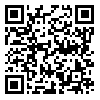Volume 18, Issue 19 (7-2020)
RSMT 2020, 18(19): 147-161 |
Back to browse issues page
Download citation:
BibTeX | RIS | EndNote | Medlars | ProCite | Reference Manager | RefWorks
Send citation to:



BibTeX | RIS | EndNote | Medlars | ProCite | Reference Manager | RefWorks
Send citation to:
Termeh M, Ghanbarzadeh A, Honarvar M, Heidari Shirazi K. Evaluation of optimal step length in a seven-link model with margin of stability method. RSMT 2020; 18 (19) :147-161
URL: http://jsmt.khu.ac.ir/article-1-440-en.html
URL: http://jsmt.khu.ac.ir/article-1-440-en.html
, Ghanbarzadeh.A@scu.ac.ir
Abstract: (3490 Views)
In a walking cycle design, maximizing the upright balance should be considered in addition to the kinematic constraints, energy consumption rate must be considered. The purpose of this study is to find the optimal step length obtained for each person according to the physical features. In this research, in order to minimize energy consumption rate by considering maximum balance two cost function were defined. the fall cost function was designed based on the concept of MOS and balance index. To investigate the upright balance and to reconstruct the movement pattern, Data from normal walking gait of healthy subjects was taken and seven links model was defined. In this study, the optimal step length was obtained for the person with height, weight and gait cycle characteristics. it is shown that for a person of 92kg mass and 1.87 meters height, the best step length in walking would be 0.54 meters. In this study, the kinematic and kinetic characteristics of human motion were identified by the analysis of gait patterns on a treadmill. Through the calculation of the balance index, individuals are helped to find the optimal step length for which the maximum balance is achieved. The results of the study can provide the optimal step length to correct the gait pattern.
Type of Study: Research |
Received: 2020/07/19 | Accepted: 2020/07/15 | Published: 2020/07/15
Received: 2020/07/19 | Accepted: 2020/07/15 | Published: 2020/07/15
References
1. Dyson, G.H.G. (1989). The Mechanics of Athletics. Holmes & Meier Publishers, New York.
2. Borelli, G.A. (1977). On the Movement of Animals, Springer.
3. Patla, A., Frank, J., Winter, D. (1990). Assessment of balance control in the elderly: major issues. Physiotherapy Canada. 42(2):89-97. [DOI:10.3138/ptc.42.2.089]
4. Kuo, A.D. (1995). An optimal control model for analyzing human postural balance. IEEE Transactions on Biomedical Engineering. 42(1):87-101. [DOI:10.1109/10.362914]
5. Winter, D.A. (1995). A.B.C (anatomy, Biomechanics and control) of balance during standing and walking. Waterloo Biomechanics.
6. Winter,D.A. (1995). Human balance and posture control during standing and walking. Gait & Posture. 3(4):193-214. [DOI:10.1016/0966-6362(96)82849-9]
7. Bottcher, S. ( 2006). Principles of robot locomotion, in: Proc. Human Robot Interaction Seminar.
8. Elftman, H. (1966). Biomechanics of muscle: with particular application to studies of gait. The Journal of Bone and Joint surgery. 48(2):363-77. [DOI:10.2106/00004623-196648020-00017]
9. Vukobratovic,M., Frank, A.A. Juricic, D. (1970). On the stability of biped locomotion. IEEE Transactions on Biomedical Engineering. 17(1):25-36. [DOI:10.1109/TBME.1970.4502681]
10. Pai, Y.C., Patton, J. (1997). Center of mass velocity-position predictions for balance control. Journal of Biomechanics. 30(4):347-54. [DOI:10.1016/S0021-9290(96)00165-0]
11. Iqbal, K. Pai, Y.C. (2000). Predicted region of stability for balance recovery: motion at the knee joint can improve termination of forward movement. Journal of Biomechanics. 33(12):1619-27. [DOI:10.1016/S0021-9290(00)00129-9]
12. Hof, A., Gazendam, M., Sinke, W. (2005). The condition for dynamic stability. Journal of Biomechanics. 38(1):1-8. [DOI:10.1016/j.jbiomech.2004.03.025]
13. Hof, A., Curtze, L.C.A. (2016) . Stricter condition for standing balance after unexpected perturbations. Journal of Biomechanics. 49(4):580-5. [DOI:10.1016/j.jbiomech.2016.01.021]
14. Honarvarmahjoobin, M.H., Nakashima, M. (2013). A new approach to find the range of feasible movements of a body for the control of balance. Journal of Biomechanical Science and Engineering. 8(2):180-96. [DOI:10.1299/jbse.8.180]
15. Honarvar, M.H., Nakashima, M. (2014). A new measure for upright stability. Journal of Biomechanics. 47(2):560-7. [DOI:10.1016/j.jbiomech.2013.09.028]
16. Honarvar, M.H., Nakashima, M. (2013). Prediction of postural risk of fall initiation based on a two-variable description of body dynamics: Position and velocity of center of mass. Human Movement Science. 32(5):1186-99. [DOI:10.1016/j.humov.2012.11.009]
17. Honarvar, M.H. ( 2016). Quantifying one's mechanical ability to control upright balance based on the probability of recovery, in: 23rd Iranian Conference on Biomedical Engineering and 2016 1st International Iranian Conference on Biomedical Engineering (ICBME), IEEE. 193-8. [DOI:10.1109/ICBME.2016.7890955]
18. Goswami, A. (1999). Postural stability of biped robots and the foot-rotation indicator (FRI) point. The International Journal of Robotics Research. 18(6):523-33. [DOI:10.1177/02783649922066376]
19. Moosavian, S.A.A., Alipour, K. (2007). On the dynamic tip-over stability of wheeled mobile manipulators. International Journal of Robotics & Automation. 22(4):322-8. [DOI:10.2316/Journal.206.2007.4.206-3036]
20. Takhmar, A., Alghooneh, M., Alipour, K., Moosavian, S.A.A. (2008). MHS measure for postural stability monitoring and control of biped robots, in: 2008 IEEE/ASME International Conference on Advanced Intelligent Mechatronics, IEEE 400-5. [DOI:10.1109/AIM.2008.4601694]
21. Goswami, A., Kallem, V. (2004) . Rate of change of angular momentum and balance maintenance of biped robots, in: IEEE International Conference on Robotics and Automation, 2004. Proceedings. ICRA'04. 2004. 3785-90. [DOI:10.1109/ROBOT.2004.1308858]
22. Winter, D.A. (2009). Biomechanics and motor control of human movement. John Wiley & Sons. [DOI:10.1002/9780470549148]
Send email to the article author
| Rights and permissions | |
 |
This work is licensed under a Creative Commons Attribution-NonCommercial 4.0 International License. |







